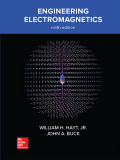
(a)
The
Answer to Problem 14.13P
The value of electric field
Explanation of Solution
Given:
The following information is given:
The radiation field
Calculation:
Using the condition
Conclusion:
The value of electric field
(b)
The
Answer to Problem 14.13P
The value of electric field
Explanation of Solution
Given:
The vertical current element location is
Concept Used:
Due to the change in the position of the vertical current element, there will be practically no change in the distance of P. However, this will enforce a change in the phase term which needs to be included in the overall electric field expression.
Calculation:
Consider two lines are drawn. One line is drawn from the origin to the point
The overall electric field will be obtained by using the modified result obtained in part (a) with the phase factor due to the path difference. The electric field will be,
Conclusion:
The value of electric field
(c)
The
Answer to Problem 14.13P
The value of electric field
Explanation of Solution
Given:
The radiation field
Identical vertical elements are located at
Concept Used:
Due to the presence of the element at
Overall electric field can be found by adding the contribution of
Calculation:
Since the phase angle of
Therefore, overall electric field will be,
Conclusion:
The value of electric field
Want to see more full solutions like this?
Chapter 14 Solutions
Engineering Electromagnetics
- 8-1) similar to Lathi & Ding, Prob. P.5.1-2 The figure below shows the Fourier spectra of signals of g,(t) and g₁(t). Determine the Nyquist rate and the corresponding sampling interval for signals of g,(t), g,(t), g₁(1) - g¸(1), g¸³(t), and g₁(1)g₁(1). Hint: Use the frequency convolution and the width property of convolution. G₁(f) G₂(f) -8000 0 8000 f -20000 10 20000 farrow_forwardCalculate the approximate values of the starting current, full-load current, and no- load current of a 150 horsepower, 575 V, 3- phase induction motor.arrow_forwardCapacitor voltage drops almost linearly during discharge and below half voltage maximum it doesn’t provide significant power. If we discharge a fully charged capacitor to its half voltage maximum, how much energy can be discharged compared to a full-discharged capacitor (show your calculation)?arrow_forward
- Design a bank of capacitors to provide 60V and 2kWh energy to capture and store regen breaking energy. Use commercial supercapacitor cells at 3V and 3600F.arrow_forwardPlease explain in step by step detail how to answer and solve this problemarrow_forwardTwo loads connected in parallel are respectively 2 kW at a pf of 0.75 leading and 4 kW at a pf of 0.95 lagging. Calculate the pf of the combined two loads. Find the complex power supplied by the source. Hints: • • Since the two loads are parallel, the complex power, S, supplied by the source is S = S₁+ S₂ Calculate the complex powers, S₁ and S2, of each load (use power triangles) and add them to find the total S. Calculate 0 and obtain pf.arrow_forward
- A 3-phase, 20-pole induction motor is con- nected to a 600 V, 60 Hz source. a. What is the synchronous speed? b. If the voltage is reduced to 300 V, will the synchronous speed change? c. How many groups are there, per phase?arrow_forwardStarting from Maxwell’s equations derive the Kirchohf’s circuit laws for voltage and current. Clearly mention what approximation is used for this derivation.arrow_forwardIn the control system shown in Figure Q4(a), G₁(s) = and G₂(s) == If the system has the specifications for the natural frequency and dampingratio of -5 rad/sec and {=0.7, respectively, determine K and H,(s) when H₂(s) = 1.arrow_forward
- Can the expert help me draw a curve on my graph paper? TERMINAL VOLTS 9000 8000 7000 6000 5000 4100 4000 14 18 22 26 30 34 38 FIELD AMPERES, If OPEN CIRCUIT CHARACTERSTICS Fig 3 42 42 46 50 54arrow_forwardSolve this problem and show all of the workarrow_forward4. A 120/240 volt 10kVA two-winding transformer is to be reconnected as a step-up 120/360 volt auto-transformer. What is the kVA rating of the new auto- transformer connection? (10 pts)arrow_forward
 Introductory Circuit Analysis (13th Edition)Electrical EngineeringISBN:9780133923605Author:Robert L. BoylestadPublisher:PEARSON
Introductory Circuit Analysis (13th Edition)Electrical EngineeringISBN:9780133923605Author:Robert L. BoylestadPublisher:PEARSON Delmar's Standard Textbook Of ElectricityElectrical EngineeringISBN:9781337900348Author:Stephen L. HermanPublisher:Cengage Learning
Delmar's Standard Textbook Of ElectricityElectrical EngineeringISBN:9781337900348Author:Stephen L. HermanPublisher:Cengage Learning Programmable Logic ControllersElectrical EngineeringISBN:9780073373843Author:Frank D. PetruzellaPublisher:McGraw-Hill Education
Programmable Logic ControllersElectrical EngineeringISBN:9780073373843Author:Frank D. PetruzellaPublisher:McGraw-Hill Education Fundamentals of Electric CircuitsElectrical EngineeringISBN:9780078028229Author:Charles K Alexander, Matthew SadikuPublisher:McGraw-Hill Education
Fundamentals of Electric CircuitsElectrical EngineeringISBN:9780078028229Author:Charles K Alexander, Matthew SadikuPublisher:McGraw-Hill Education Electric Circuits. (11th Edition)Electrical EngineeringISBN:9780134746968Author:James W. Nilsson, Susan RiedelPublisher:PEARSON
Electric Circuits. (11th Edition)Electrical EngineeringISBN:9780134746968Author:James W. Nilsson, Susan RiedelPublisher:PEARSON Engineering ElectromagneticsElectrical EngineeringISBN:9780078028151Author:Hayt, William H. (william Hart), Jr, BUCK, John A.Publisher:Mcgraw-hill Education,
Engineering ElectromagneticsElectrical EngineeringISBN:9780078028151Author:Hayt, William H. (william Hart), Jr, BUCK, John A.Publisher:Mcgraw-hill Education,





